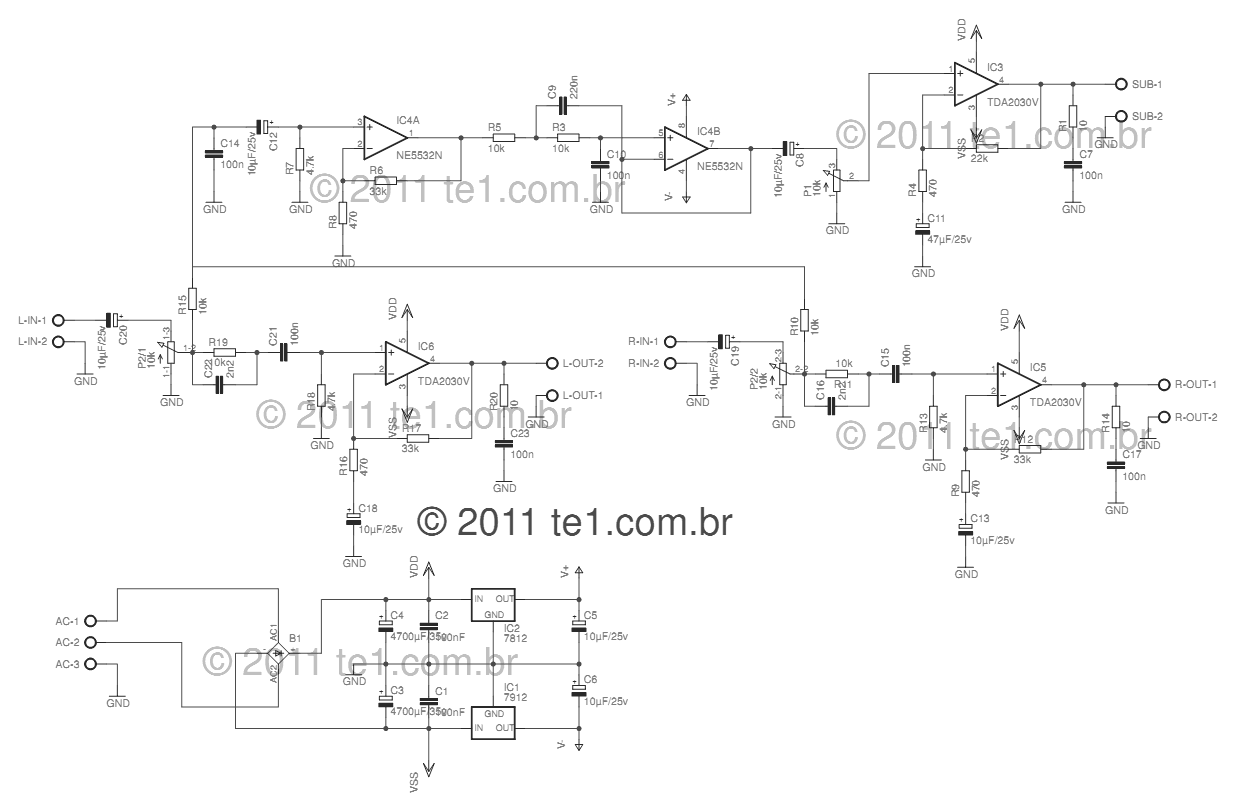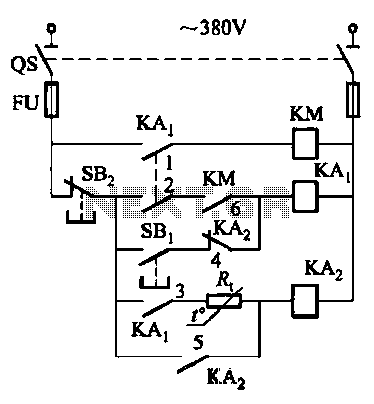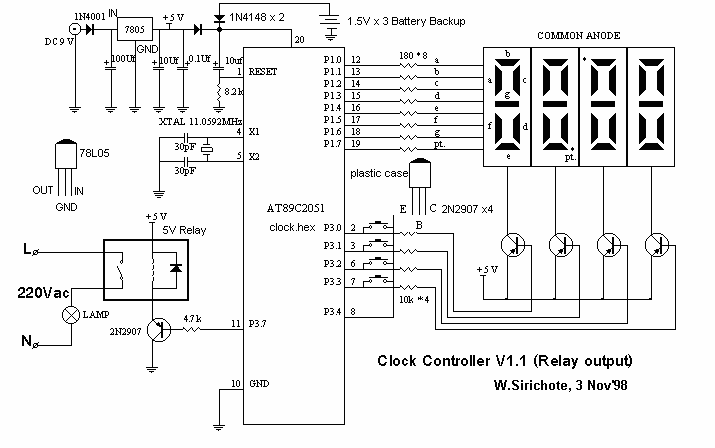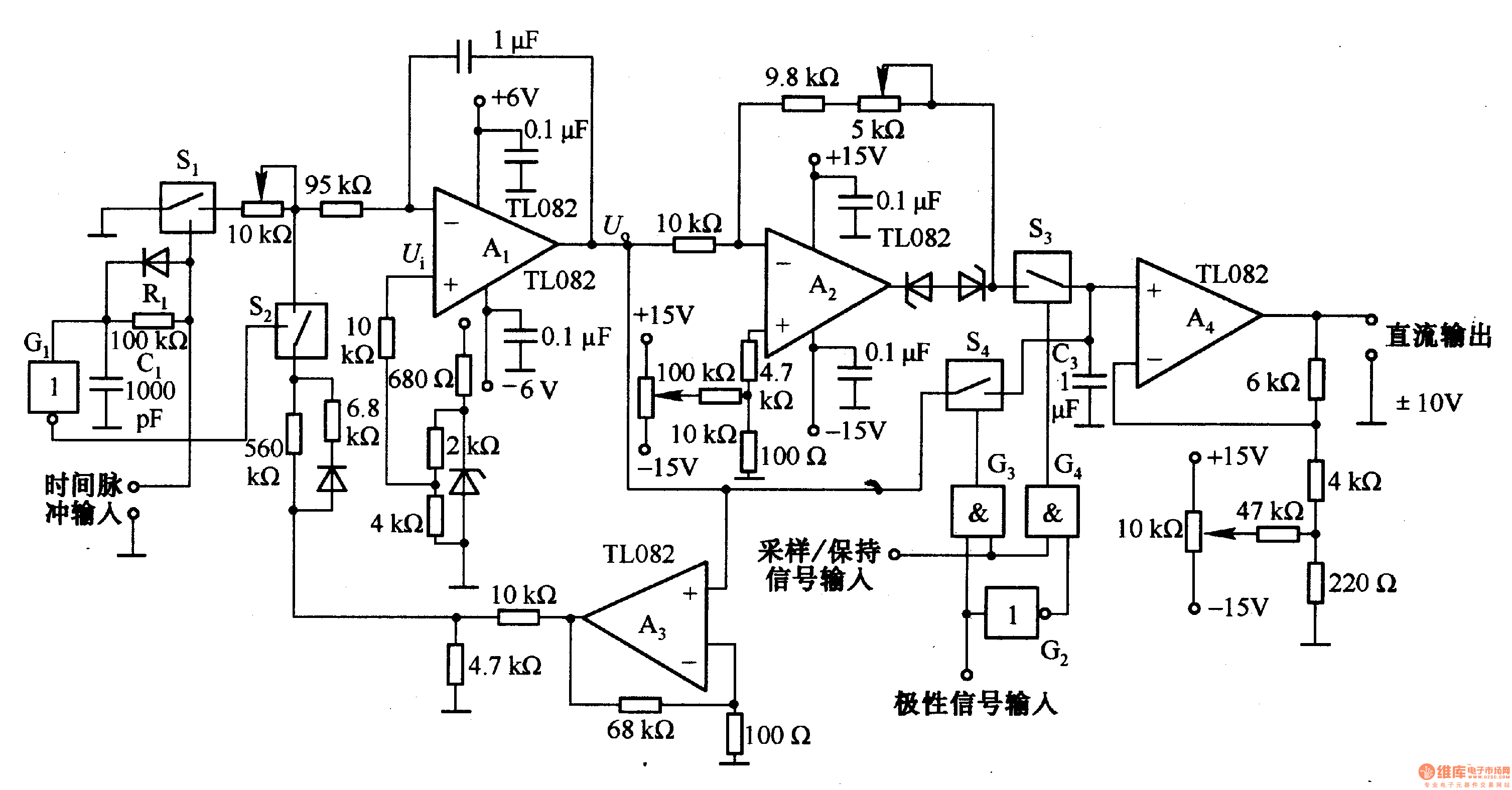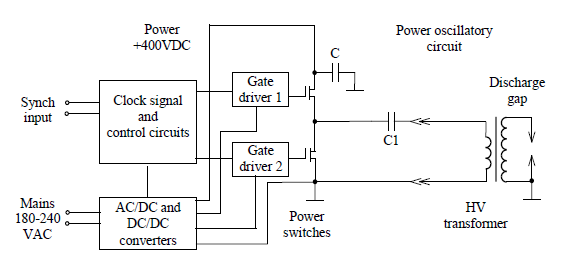
Simple Fire alarm circuit using LDR
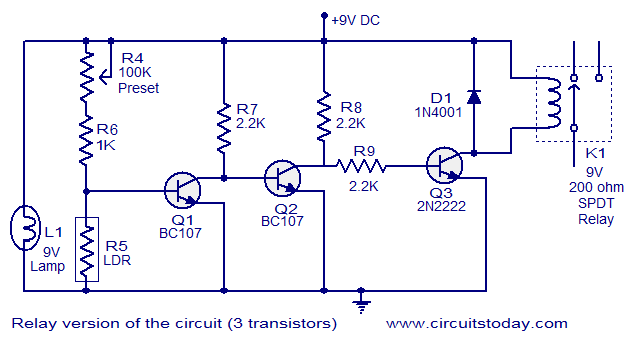
This document describes a simple fire alarm circuit utilizing a Light Dependent Resistor (LDR) and lamp combination for fire detection. The alarm activates by detecting smoke generated during a fire. When smoke is present, the circuit triggers an audible alarm. In the absence of smoke, light from the bulb directly illuminates the LDR, maintaining a low resistance and resulting in a voltage below 0.6V, keeping the transistor in the OFF state. When smoke obscures the light reaching the LDR, its resistance increases, raising the voltage across it. This causes the transistor to turn ON, supplying power to IC1, which outputs 5V to the tone generator IC UM66 (IC2) to produce sound. The audio is amplified by IC3 (TDA2002) to drive a speaker. Resistor R6 protects the transistor when R4 approaches low resistance values, while resistors R1 and R2 create a feedback network for the TDA2002, with capacitor C1 coupling the feedback signal to the inverting input of the IC. A stable power supply is crucial for the circuit, as minor voltage fluctuations can impact the transistor's biasing and overall performance. A regulated 9V/500mA power supply is recommended, utilizing a 230V primary, 12V secondary, 500mA step-down transformer (T1) and a 1A bridge rectifier (D1). Capacitor C1 filters the output, while C2 serves as an AC bypass capacitor. The 7809 IC1 functions as a 9V fixed positive voltage regulator, ensuring stable output. The circuit can be modified to operate a relay for higher power warning devices, incorporating additional transistors to switch the relay on when smoke is detected. Resistors R7 and R8 limit the collector currents of Q1 and Q2, and D1 protects Q3 from voltage spikes when the relay is activated. Resistor R9 regulates the base current of transistor Q3 (2N2222).
The fire alarm circuit operates on the principle of light interruption caused by smoke, which is detected through the LDR. The LDR's resistance changes significantly in the presence of smoke, leading to a voltage change that controls the transistor's state. This transition is crucial for activating the alarm system. The tone generator IC UM66, when powered, produces a sound that serves as an alarm, while the TDA2002 amplifies this sound to a level suitable for driving a speaker, making the alarm audible.
The power supply section is designed to ensure that the circuit functions reliably under various conditions. The transformer steps down the mains voltage to a safer level, and the bridge rectifier converts AC to DC, which is then smoothed by capacitors to provide a stable voltage to the circuit. The 7809 voltage regulator ensures that fluctuations in the supply voltage do not affect the operation of the fire sensing circuit, which is critical for reliable performance.
In the modified version of the circuit, the addition of a relay allows for the control of high-power devices, such as sirens or lights, enhancing the alarm's effectiveness. The use of transistors Q1, Q2, and Q3 in this configuration allows the circuit to manage higher loads safely. The protective components, such as the freewheeling diode, ensure that the circuit remains safe and functional, even when switching inductive loads, which can generate voltage spikes.
Overall, this fire alarm circuit is an efficient and effective design for detecting smoke and activating an alarm, with the flexibility to control additional high-power devices through the relay system.Here is a simple fire alarm circuit based on a Light Dependent Resistor (LDR) and lamp pair for sensing the fire. The alarm works by sensing the smoke produced during fire. The circuit produces an audible alarm when the fire breaks out with smoke. When there is no smoke the light from the bulb will be directly falling on the LDR. The LDR resistanc e will be low and so the voltage across it (below 0. 6V). The transistor will be OFF and nothing happens. When there is sufficient smoke to mask the light from falling on LDR, the LDR resistance increases and so do the voltage across it. Now the transistor will switch to ON. This gives power to the IC1 and it outputs 5V. This powers the tone generator IC UM66 (IC2) to play a music. This music will be amplified by IC3 (TDA 2002) to drive the speaker. Resistor R6 is meant for protecting the transistor when R4 is turned towards low resistance values. Resistor R2 and R1 forms a feedback network for the TDA2002 and C1 couples the feed back signal from the junction of R1 & R2 to the inverting input of the same IC.
CircuitsToday has a list of 4 books for electronics enthusiasts who are looking for a better chance to learn the basics and getter a better practical insight of the subject. These books are written by authentic authors like Forrest M Mims, Charles Platt and so on. You can read their reviews and buy them online here:- 4 GREAT BOOKS TO LEARN BASIC ELECTRONICS. A well regulated power supply is essential for this circuit because even slight variations in the supply voltage could alter the biasing of the transistor used in the fire sensing section and this could seriously affect the circuit`s performance.
A regulated 9V/500mA power supply that can be used for powering the basic fire alarm circuit and its modified versions is shown above. Transformer T1 is a 230V primary, 12V secondary, 500mA step down transformer. D1 is a 1A bridge which performs the job of rectification. Capacitor C1 filters the rectifier output and C2 is the AC by-pass capacitor. IC1 (7809) is a 9V fixed positive voltage regulator. The output of the rectifier+filter section is connected to the input of 7805 and a regulated steady 9V is obtained at its output.
S1 is the ON/OFF switch. F1 is a 500mA safety fuse. Here the above fire alarm circuit is modified to operate a relay when the fire breaks out. The usage of relay makes the circuit able to switch high power warning devices like alarms, bells, beacon lights etc that operates from the mains. Two additional transistors are used with the basic fire sensing circuitry (consisting of Q1, R4, R5 and L1) to attain the target.
Whenever the fire breaks out the transistor Q1 is switched ON. The collector voltage of Q1 drops to 0. 2V and the transistor Q2 gets switched OFF. This makes the collector voltage of Q2 rise towards 9V and this result in the switching ON of transistor Q3. The relay connected at the collector of Q3 is activated and the load connected through the relay contact is driven.
Resistors R7 and R8 limits the collector current of Q1 and Q2 respectively. D1 is a freewheeling diode which protects Q3 from the voltage spikes induced when the relay is switched. Resistor R9 controls the base current of transistor Q3 (2N2222). 🔗 External reference
The fire alarm circuit operates on the principle of light interruption caused by smoke, which is detected through the LDR. The LDR's resistance changes significantly in the presence of smoke, leading to a voltage change that controls the transistor's state. This transition is crucial for activating the alarm system. The tone generator IC UM66, when powered, produces a sound that serves as an alarm, while the TDA2002 amplifies this sound to a level suitable for driving a speaker, making the alarm audible.
The power supply section is designed to ensure that the circuit functions reliably under various conditions. The transformer steps down the mains voltage to a safer level, and the bridge rectifier converts AC to DC, which is then smoothed by capacitors to provide a stable voltage to the circuit. The 7809 voltage regulator ensures that fluctuations in the supply voltage do not affect the operation of the fire sensing circuit, which is critical for reliable performance.
In the modified version of the circuit, the addition of a relay allows for the control of high-power devices, such as sirens or lights, enhancing the alarm's effectiveness. The use of transistors Q1, Q2, and Q3 in this configuration allows the circuit to manage higher loads safely. The protective components, such as the freewheeling diode, ensure that the circuit remains safe and functional, even when switching inductive loads, which can generate voltage spikes.
Overall, this fire alarm circuit is an efficient and effective design for detecting smoke and activating an alarm, with the flexibility to control additional high-power devices through the relay system.Here is a simple fire alarm circuit based on a Light Dependent Resistor (LDR) and lamp pair for sensing the fire. The alarm works by sensing the smoke produced during fire. The circuit produces an audible alarm when the fire breaks out with smoke. When there is no smoke the light from the bulb will be directly falling on the LDR. The LDR resistanc e will be low and so the voltage across it (below 0. 6V). The transistor will be OFF and nothing happens. When there is sufficient smoke to mask the light from falling on LDR, the LDR resistance increases and so do the voltage across it. Now the transistor will switch to ON. This gives power to the IC1 and it outputs 5V. This powers the tone generator IC UM66 (IC2) to play a music. This music will be amplified by IC3 (TDA 2002) to drive the speaker. Resistor R6 is meant for protecting the transistor when R4 is turned towards low resistance values. Resistor R2 and R1 forms a feedback network for the TDA2002 and C1 couples the feed back signal from the junction of R1 & R2 to the inverting input of the same IC.
CircuitsToday has a list of 4 books for electronics enthusiasts who are looking for a better chance to learn the basics and getter a better practical insight of the subject. These books are written by authentic authors like Forrest M Mims, Charles Platt and so on. You can read their reviews and buy them online here:- 4 GREAT BOOKS TO LEARN BASIC ELECTRONICS. A well regulated power supply is essential for this circuit because even slight variations in the supply voltage could alter the biasing of the transistor used in the fire sensing section and this could seriously affect the circuit`s performance.
A regulated 9V/500mA power supply that can be used for powering the basic fire alarm circuit and its modified versions is shown above. Transformer T1 is a 230V primary, 12V secondary, 500mA step down transformer. D1 is a 1A bridge which performs the job of rectification. Capacitor C1 filters the rectifier output and C2 is the AC by-pass capacitor. IC1 (7809) is a 9V fixed positive voltage regulator. The output of the rectifier+filter section is connected to the input of 7805 and a regulated steady 9V is obtained at its output.
S1 is the ON/OFF switch. F1 is a 500mA safety fuse. Here the above fire alarm circuit is modified to operate a relay when the fire breaks out. The usage of relay makes the circuit able to switch high power warning devices like alarms, bells, beacon lights etc that operates from the mains. Two additional transistors are used with the basic fire sensing circuitry (consisting of Q1, R4, R5 and L1) to attain the target.
Whenever the fire breaks out the transistor Q1 is switched ON. The collector voltage of Q1 drops to 0. 2V and the transistor Q2 gets switched OFF. This makes the collector voltage of Q2 rise towards 9V and this result in the switching ON of transistor Q3. The relay connected at the collector of Q3 is activated and the load connected through the relay contact is driven.
Resistors R7 and R8 limits the collector current of Q1 and Q2 respectively. D1 is a freewheeling diode which protects Q3 from the voltage spikes induced when the relay is switched. Resistor R9 controls the base current of transistor Q3 (2N2222). 🔗 External reference
